HOTSPOT -
Select the answer that correctly completes the sentence.
Hot Area: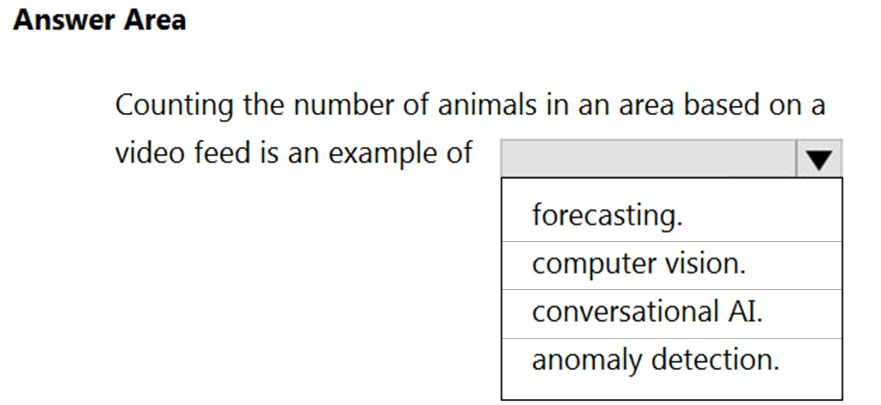
Answer:

Reference:
https://docs.microsoft.com/en-us/azure/cognitive-services/computer-vision/overview https://docs.microsoft.com/en-us/azure/cognitive-services/computer-vision/intro-to-spatial-analysis-public-preview
HOTSPOT -
You have a database that contains a list of employees and their photos.
You are tagging new photos of the employees.
For each of the following statements select Yes if the statement is true. Otherwise, select No.
NOTE: Each correct selection is worth one point.
Hot Area: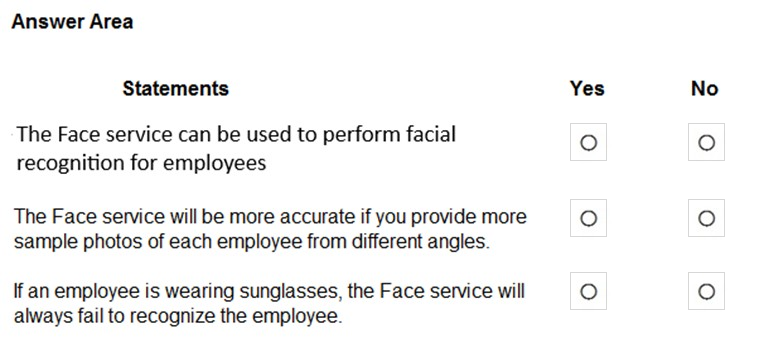
Answer:
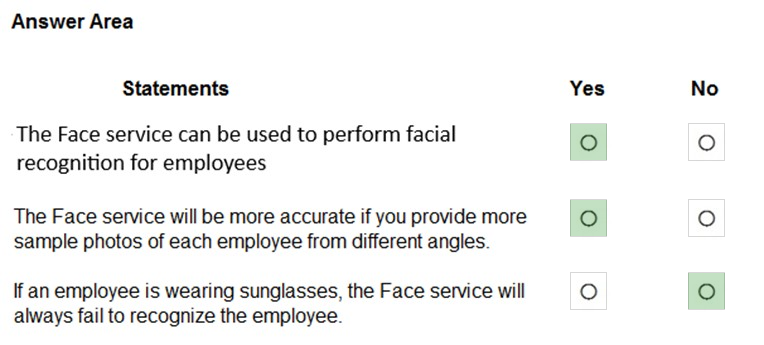
Reference:
https://docs.microsoft.com/en-us/azure/cognitive-services/face/overview https://docs.microsoft.com/en-us/azure/cognitive-services/face/concepts/face-detection
You need to develop a mobile app for employees to scan and store their expenses while travelling.
Which type of computer vision should you use?
Answer:
D
Azure's Computer Vision API includes Optical Character Recognition (OCR) capabilities that extract printed or handwritten text from images. You can extract text from images, such as photos of license plates or containers with serial numbers, as well as from documents - invoices, bills, financial reports, articles, and more.
Reference:
https://docs.microsoft.com/en-us/azure/cognitive-services/computer-vision/concept-recognizing-text
HOTSPOT -
For each of the following statements, select Yes if the statement is true. Otherwise, select No.
NOTE: Each correct selection is worth one point.
Hot Area: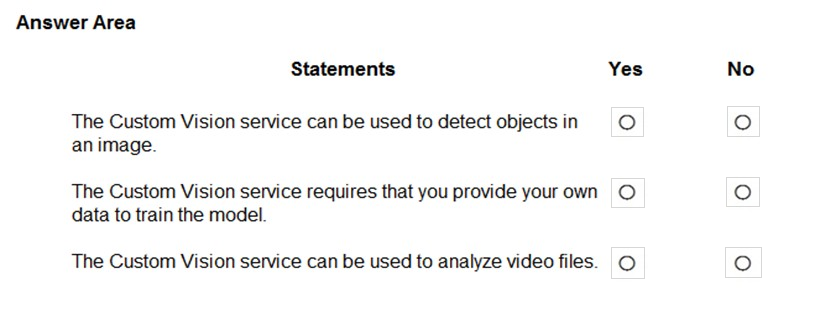
Answer:
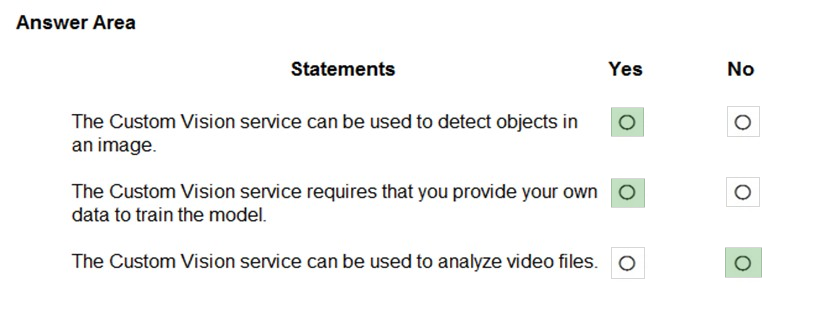
Box 1: Yes -
Custom Vision functionality can be divided into two features. Image classification applies one or more labels to an image. Object detection is similar, but it also returns the coordinates in the image where the applied label(s) can be found.
Box 2: Yes -
The Custom Vision service uses a machine learning algorithm to analyze images. You, the developer, submit groups of images that feature and lack the characteristics in question. You label the images yourself at the time of submission. Then, the algorithm trains to this data and calculates its own accuracy by testing itself on those same images.
Box 3: No -
Custom Vision service can be used only on graphic files.
Reference:
https://docs.microsoft.com/en-us/azure/cognitive-services/Custom-Vision-Service/overview
HOTSPOT -
For each of the following statements, select Yes if the statement is true. Otherwise, select No.
NOTE: Each correct selection is worth one point.
Hot Area: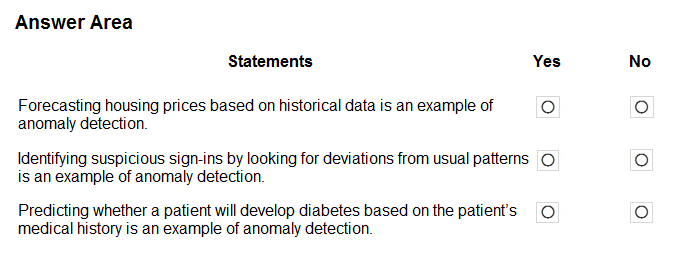
Answer:

Anomaly detection encompasses many important tasks in machine learning:
Identifying transactions that are potentially fraudulent.
Learning patterns that indicate that a network intrusion has occurred.
Finding abnormal clusters of patients.
Checking values entered into a system.
Reference:
https://docs.microsoft.com/en-us/azure/machine-learning/studio-module-reference/anomaly-detection
HOTSPOT -
To complete the sentence, select the appropriate option in the answer area.
Hot Area: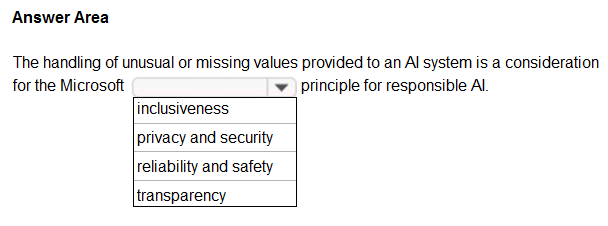
Answer:
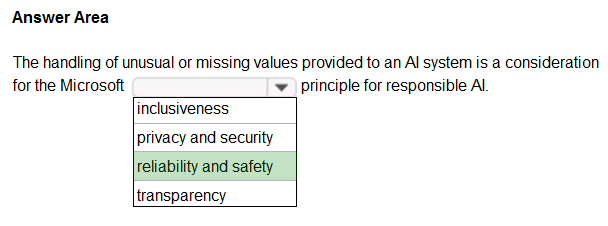
Reliability and safety:
AI systems need to be reliable and safe in order to be trusted. It is important for a system to perform as it was originally designed and for it to respond safely to new situations. Its inherent resilience should resist intended or unintended manipulation. Rigorous testing and validation should be established for operating conditions to ensure that the system responds safely to edge cases, and A/B testing and champion/challenger methods should be integrated into the evaluation process.
An AI system's performance can degrade over time, so a robust monitoring and model tracking process needs to be established to reactively and proactively measure the model's performance and retrain it, as necessary, to modernize it.
Reference:
https://docs.microsoft.com/en-us/azure/cloud-adoption-framework/innovate/best-practices/trusted-ai
DRAG DROP -
Match the types of AI workloads to the appropriate scenarios.
To answer, drag the appropriate workload type from the column on the left to its scenario on the right. Each workload type may be used once, more than once, or not at all.
NOTE: Each correct selection is worth one point.
Select and Place: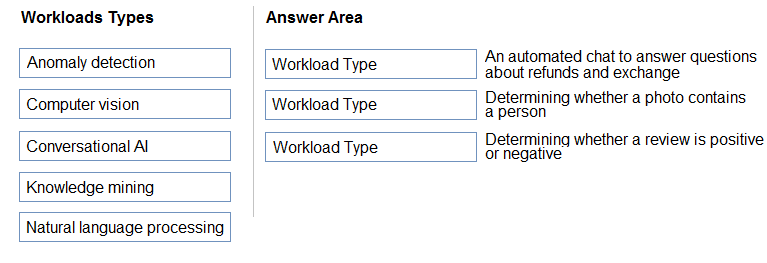
Answer:
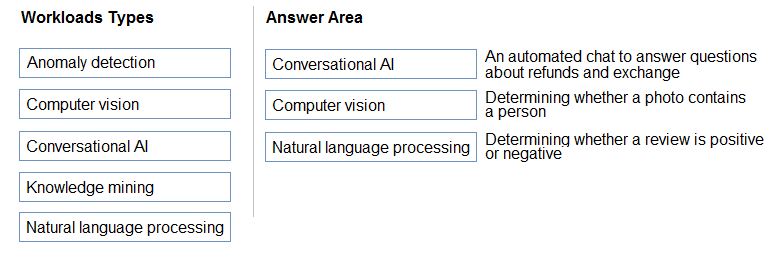
Box 3: Natural language processing
Natural language processing (NLP) is used for tasks such as sentiment analysis, topic detection, language detection, key phrase extraction, and document categorization.
Reference:
https://docs.microsoft.com/en-us/azure/architecture/data-guide/technology-choices/natural-language-processing
You are designing an AI system that empowers everyone, including people who have hearing, visual, and other impairments.
This is an example of which Microsoft guiding principle for responsible AI?
Answer:
B
Inclusiveness: At Microsoft, we firmly believe everyone should benefit from intelligent technology, meaning it must incorporate and address a broad range of human needs and experiences. For the 1 billion people with disabilities around the world, AI technologies can be a game-changer.
Reference:
https://docs.microsoft.com/en-us/learn/modules/responsible-ai-principles/4-guiding-principles
You are processing photos of runners in a race.
You need to read the numbers on the runners' shirts to identity the runners in the photos.
Which type of computer vision should you use?
Answer:
B
Optical character recognition (OCR) allows you to extract printed or handwritten text from images and documents.
Reference:
https://docs.microsoft.com/en-us/azure/cognitive-services/computer-vision/overview-ocr
DRAG DROP -
Match the types of machine learning to the appropriate scenarios.
To answer, drag the appropriate machine learning type from the column on the left to its scenario on the right. Each machine learning type may be used once, more than once, or not at all.
NOTE: Each correct selection is worth one point.
Select and Place:
Answer:

Box 1: Image classification -
Image classification is a supervised learning problem: define a set of target classes (objects to identify in images), and train a model to recognize them using labeled example photos.
Box 2: Object detection -
Object detection is a computer vision problem. While closely related to image classification, object detection performs image classification at a more granular scale. Object detection both locates and categorizes entities within images.
Box 3: Semantic Segmentation -
Semantic segmentation achieves fine-grained inference by making dense predictions inferring labels for every pixel, so that each pixel is labeled with the class of its enclosing object ore region.
Reference:
https://developers.google.com/machine-learning/practica/image-classification https://docs.microsoft.com/en-us/dotnet/machine-learning/tutorials/object-detection-model-builder https://nanonets.com/blog/how-to-do-semantic-segmentation-using-deep-learning/